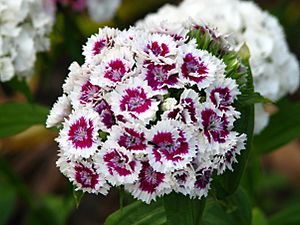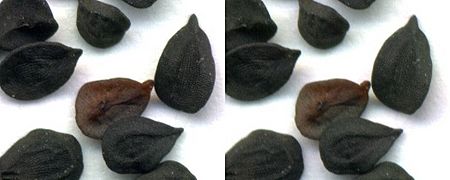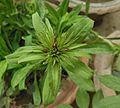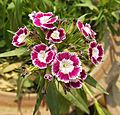Sweet William facts for kids
Quick facts for kids Sweet William |
|
|---|---|
 |
|
| Scientific classification | |
| Genus: |
Dianthus
|
| Species: |
barbatus
|
The sweet William (scientific name: Dianthus barbatus) is a beautiful flowering plant. It belongs to the carnation family and is originally from southern Europe and parts of Asia. Today, it's a very popular plant grown in gardens all over the world.
Sweet William plants can grow from about 13 to 92 centimeters tall. They are usually biennial plants, meaning they live for two years. Sometimes, they can be short-lived perennials, living a bit longer. Their flowers grow in a tight bunch of up to 30 flowers at the top of the stems. Each flower is about 2 to 3 centimeters wide. They have five petals with pretty jagged edges. Wild sweet William plants usually have red flowers with a white base. But garden varieties come in many colors like white, pink, red, purple, and even mixed patterns!
The flowers are safe to eat and can attract bees, birds, and butterflys to your garden.
Contents
What Sweet William Looks Like
Sweet William plants grow in the mountains of southern Europe. You can find them from the Pyrenees to the Carpathians and the Balkans. There's also a type that grows far away in northeastern China, Korea, and southeastern Russia.
These plants can reach different heights, from 13 to 92 centimeters, depending on the type. Their leaves are green or a cool blue-green color. They are tapered, meaning they get narrower at the ends. The leaves are usually 4 to 10 centimeters long and 1 to 2 centimeters wide.
The flowers grow in a thick cluster of up to 30 flowers at the top of the stems. This cluster is called an umbel. The flowers have a lovely spicy, clove-like smell. Each flower has five petals with serrated (saw-like) edges. In the wild, the petals are red with a white base.
There are two main types, or varieties, of sweet William:
- Dianthus barbatus var. barbatus: This type is found in southern Europe. Its leaves are wider, up to 2 centimeters across.
- Dianthus barbatus var. asiaticus Nakai: This type grows in northeastern Asia. Its leaves are thinner, usually not more than 1 centimeter wide.
The Story Behind the Name

No one is completely sure how sweet William got its English name. Many fun stories try to explain it, but none are proven true.
One popular story says it was named after Prince William, Duke of Cumberland. He was an important person in the 1700s. Because of his victory at the Battle of Culloden, some people jokingly called a different plant, the ragwort, "stinking willy." This was a way to remember the Duke.
Other stories suggest the flower was named after famous people like William Shakespeare. Some even say it was named after Saint William of York or William the Conqueror.
Another idea is that "William" might come from the French word oeillet. This word means both "carnation" (which is in the same family as sweet William) and "little eye."
In old English folk songs, "Sweet William" was a common name for a young man in love. This shows how popular and well-loved the name was! The first time the name "sweet William" appeared in writing was in 1596. It was in a garden list by a botanist named John Gerard.
Growing and Using Sweet William
| Stereo image
|
||
|
||
|
||
|
||
|
||
| Sweet William seeds |
Sweet William is a very popular ornamental plant for gardens. There are many different types, called cultivars, and hybrids. These have been specially grown for their amazing flower colors. You can find them in white, pink, red, purple, and even with mixed patterns.
This plant first came to northern Europe in the 1500s. Later, it traveled to North America and other places. It has now started growing naturally in many of these new areas.
Sweet William is great for flower arrangements because of its height. In the Victorian language of flowers, sweet William meant "gallantry," which is like being brave and polite. It looks lovely in garden borders, rock gardens, and natural-looking country cottage gardens.
Sweet William is a good choice for a natural garden. Its sweet nectar attracts birds, bees, and butterflys. Plus, its flowers are considered edible, meaning you can eat them!
Sweet William is a type of Dianthus flower. It grows best in rich, slightly alkaline soil. It likes a spot with lots of sun or a little bit of shade. You can grow new plants from seeds, cuttings, or by dividing the plant. However, if you use seeds from special varieties, they might not grow into the exact same type of flower.
If you plant sweet William seeds after the last frost in spring, the flowers will usually appear in the second year. But if you start the seeds indoors before the last frost and then plant them outside, they might flower in the first year. Some gardeners suggest removing faded flowers (called deadheading) to help the plant grow more new flowers. Sweet William plants can also reseed themselves, meaning they drop seeds that grow into new plants on their own.
A fun fact: At the wedding of Prince William and Catherine Middleton on April 29, 2011, Catherine Middleton included sweet William flowers in her wedding bouquet! This was a special way to honor her husband.
Images for kids
















